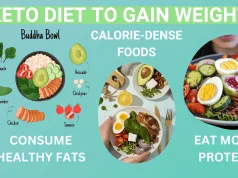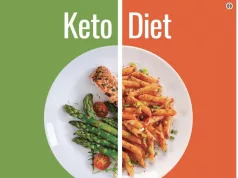How to lose weight and get toned is a common goal, but it’s important to understand that these two things aren’t mutually exclusive. Losing weight and gaining muscle tone require a balanced approach that considers both nutrition and exercise.
While shedding pounds can improve your overall health, building muscle can boost your metabolism, increase strength, and enhance your body composition.
This guide will explore the key elements of a successful weight loss and toning journey, covering everything from setting realistic goals to incorporating sustainable lifestyle changes. We’ll delve into the importance of nutrition, exercise, and rest, providing practical tips and strategies to help you achieve your desired results.
Understanding Weight Loss and Toning
Weight loss and muscle toning are two distinct yet interconnected aspects of fitness. While both contribute to a healthier lifestyle, they involve different processes and require specific strategies. Understanding the difference between them is crucial for achieving your desired results effectively.
The Difference Between Weight Loss and Muscle Toning
Weight loss refers to the reduction of overall body fat, primarily achieved by consuming fewer calories than you burn. Muscle toning, on the other hand, involves increasing the size and strength of your muscles through resistance training. It doesn’t necessarily lead to significant weight loss but alters your body composition by replacing fat with muscle.
The Importance of a Balanced Approach
A balanced approach that incorporates both weight loss and muscle toning is essential for achieving optimal health and fitness. Focusing solely on weight loss can lead to muscle loss, which can negatively impact your metabolism and overall strength. Conversely, focusing only on muscle toning without addressing weight loss may not result in the desired body shape or weight reduction.
Benefits of Losing Weight and Gaining Muscle Tone
- Improved Body Composition:Losing weight and gaining muscle tone results in a more favorable body composition, with less fat and more muscle mass. This contributes to a healthier and more toned appearance.
- Enhanced Metabolism:Muscle tissue burns more calories than fat tissue, even at rest. Building muscle through toning can boost your metabolism, making it easier to maintain a healthy weight.
- Increased Strength and Endurance:Muscle toning improves your strength and endurance, making daily activities easier and allowing you to participate in more physical activities.
- Reduced Risk of Chronic Diseases:Losing weight and gaining muscle tone can reduce your risk of developing chronic diseases such as heart disease, type 2 diabetes, and certain types of cancer.
- Improved Mood and Confidence:Achieving your fitness goals can boost your self-esteem and confidence, leading to a more positive outlook on life.
Setting Realistic Goals
Setting realistic goals is crucial for successful weight loss and toning. It’s about making gradual, sustainable changes to your lifestyle rather than seeking quick fixes that often lead to disappointment and setbacks.
Importance of Gradual Progress
Gradual progress is more likely to lead to long-term success. Aiming for a rapid weight loss of more than 1-2 pounds per week can be unsustainable and can lead to muscle loss and a decrease in metabolism.
- A sustainable rate of weight loss is generally considered to be 1-2 pounds per week.
- This gradual approach allows your body to adapt to changes in your diet and exercise routine, making it more likely that you will maintain your weight loss over time.
Avoiding Quick Fixes
Quick fixes often promise dramatic results in a short period, but they are rarely sustainable. They may involve extreme diets, fad exercises, or weight loss supplements.
Losing weight and getting toned is a journey that requires dedication and a balanced approach. While focusing on overall fitness is crucial, some might want to target specific areas like the face. If you’re looking to slim down your face, you can explore strategies like reducing sodium intake, staying hydrated, and incorporating facial exercises.
How to lose weight in your face provides valuable insights on this topic. Remember, achieving a toned physique is a gradual process that involves a healthy diet, regular exercise, and patience.
- These methods can be unhealthy and may even be harmful to your body.
- They often lead to yo-yo dieting, where you lose weight quickly only to gain it back again.
Staying Motivated and Tracking Progress
Staying motivated is essential for achieving your goals.
- Tracking your progress can help you stay motivated and see how far you have come.
- Keeping a food journal can help you identify areas where you can make changes to your diet.
- Taking measurements and photos can also help you track your progress and celebrate your achievements.
Nutrition for Weight Loss and Toning

The foundation of successful weight loss and muscle toning lies in a balanced and nutritious diet. While exercise is crucial, your dietary choices play a significant role in shaping your body composition. This section will delve into the essential nutrients for weight loss and muscle building, along with practical tips for making healthy food choices.
Understanding Macronutrients
Macronutrients are the primary building blocks of food, providing the energy your body needs to function. The three main macronutrients are:
- Protein: Essential for building and repairing muscle tissue. Aim for 0.8 grams of protein per kilogram of body weight daily.
- Carbohydrates: Provide energy for your body’s daily activities. Choose complex carbohydrates like whole grains, fruits, and vegetables over simple sugars found in processed foods.
- Healthy Fats: Important for hormone production, cell function, and satiety. Opt for unsaturated fats found in avocados, nuts, seeds, and olive oil.
Sample Meal Plan, How to lose weight and get toned
This sample meal plan demonstrates a balanced approach to nutrition for weight loss and toning. Remember, individual needs may vary, so consult with a registered dietitian for personalized guidance.
- Breakfast: Oatmeal with berries and a handful of almonds.
- Lunch: Grilled chicken salad with mixed greens, avocado, and a light vinaigrette.
- Dinner: Baked salmon with roasted vegetables and brown rice.
- Snacks: Greek yogurt with fruit, a handful of trail mix, or a protein shake.
Tips for Making Healthy Food Choices
Making healthy food choices can be challenging, but with a few simple strategies, you can create a sustainable and enjoyable eating pattern.
- Read Food Labels: Pay attention to serving sizes, calories, and macronutrient content.
- Choose Whole Foods: Opt for unprocessed foods like fruits, vegetables, lean proteins, and whole grains.
- Cook More Meals at Home: This gives you control over ingredients and portion sizes.
- Hydrate Regularly: Drink plenty of water throughout the day.
- Limit Processed Foods: Processed foods are often high in calories, sugar, and unhealthy fats.
Exercise for Weight Loss and Toning: How To Lose Weight And Get Toned

Regular exercise is crucial for both weight loss and muscle toning. It burns calories, boosts metabolism, and helps build lean muscle mass. To effectively combine cardio and strength training for weight loss and toning, consider a balanced routine that targets different muscle groups and incorporates both types of exercise.
Sample Workout Routine
A sample workout routine combining cardio and strength training could look like this:
- Warm-up:Start with 5-10 minutes of light cardio, such as jogging in place, jumping jacks, or dynamic stretching. This prepares your body for more intense exercise.
- Cardio:Engage in 30-45 minutes of moderate-intensity cardio, such as brisk walking, running, swimming, cycling, or dancing. This helps burn calories and improve cardiovascular health.
- Strength Training:Perform 2-3 sets of 8-12 repetitions for each exercise, focusing on major muscle groups. Examples include squats, lunges, push-ups, rows, and bicep curls. This builds muscle mass and increases metabolism.
- Cool-down:Finish with 5-10 minutes of stretching, focusing on the muscle groups you worked during the workout. This helps improve flexibility and reduce muscle soreness.
Importance of Consistency and Proper Form
Consistency is key to achieving weight loss and toning goals. Aim for at least 3-4 workouts per week, allowing for rest days between sessions. It’s equally important to focus on proper form during exercises to prevent injuries and maximize results.
Proper form ensures that you are engaging the correct muscles and performing the exercise effectively. If you are unsure about proper form, consult a certified personal trainer or fitness professional.
Adjusting Exercise Intensity
Adjusting exercise intensity based on individual fitness levels is crucial for maximizing results and preventing injury. Beginners should start with shorter durations and lower intensity exercises, gradually increasing as their fitness improves. Advanced exercisers can challenge themselves with longer durations, higher intensity, and heavier weights.
Achieving a toned physique often involves a combination of exercise and diet, but there are alternative approaches. If you’re looking for ways to shed pounds without hitting the gym or drastically changing your eating habits, you might be interested in exploring strategies outlined in this article: How to lose weight without exercise and diet.
While these methods may not lead to the same level of muscle definition as traditional fitness routines, they can still contribute to weight loss and overall well-being.
Remember, the key is to listen to your body and adjust the intensity accordingly. If you are feeling pain or discomfort, stop the exercise and rest.
Importance of Rest and Recovery
Rest and recovery are often overlooked aspects of a weight loss and toning journey, but they are just as crucial as exercise and nutrition. While it may seem counterintuitive, taking time to rest and recover allows your body to repair and rebuild muscle tissue, which is essential for both weight loss and muscle gain.
The Role of Sleep in Weight Loss and Muscle Recovery
Sleep is essential for weight loss and muscle recovery. During sleep, your body releases hormones that help with muscle repair and growth, as well as regulating appetite and metabolism. Lack of sleep can disrupt these processes, leading to increased hunger, decreased metabolism, and impaired muscle recovery.
Aim for 7-9 hours of quality sleep per night to optimize your body’s ability to recover and build muscle.
Getting toned is a great way to improve your overall fitness, but the real challenge lies in maintaining those results. Losing weight and keeping it off for good requires a holistic approach, focusing on healthy habits that you can sustain over the long term.
Check out How to lose weight and keep it off for good for tips on how to make sustainable lifestyle changes. Once you’ve established a healthy foundation, you can then focus on building muscle and sculpting your physique through regular exercise and a balanced diet.
Tips for Getting Enough Rest and Avoiding Overtraining
- Prioritize sleep: Make sleep a priority by establishing a regular sleep schedule and creating a relaxing bedtime routine. Avoid screen time an hour before bed and ensure your bedroom is dark, quiet, and cool.
- Listen to your body: Pay attention to your body’s signals and don’t push yourself too hard. If you’re feeling fatigued or sore, take a rest day. Overtraining can lead to injuries and hinder your progress.
- Incorporate rest days: Schedule at least one or two rest days per week to allow your body to recover fully. On rest days, engage in light activities like walking, stretching, or yoga to promote blood flow and flexibility.
Benefits of Active Recovery Days
Active recovery days involve light physical activity that helps with muscle recovery and improves blood flow without putting excessive stress on your body. Examples include:
- Walking: A gentle walk at a moderate pace can help to flush out lactic acid and improve circulation.
- Swimming: Swimming is a low-impact exercise that can help to improve cardiovascular health and muscle recovery.
- Yoga: Yoga poses can help to improve flexibility, reduce muscle soreness, and promote relaxation.
Final Summary
Transforming your body and achieving a healthy weight and toned physique is a journey, not a sprint. It requires patience, dedication, and a commitment to making lasting changes. Remember, there’s no one-size-fits-all approach. By understanding the principles of weight loss and muscle toning, setting realistic goals, and making gradual progress, you can create a sustainable lifestyle that supports your overall well-being and helps you reach your desired outcome.
So, embrace the journey, celebrate your progress, and enjoy the process of becoming a healthier, stronger, and more confident you.
Essential FAQs
What are some common weight loss plateaus and how to overcome them?
Weight loss plateaus are common and can be caused by various factors, including a decrease in calorie intake, a plateau in muscle growth, or hormonal fluctuations. To overcome plateaus, consider adjusting your calorie intake, increasing exercise intensity or duration, and incorporating new exercises to stimulate muscle growth.
What are the best exercises for toning specific muscle groups?
Targeted exercises are crucial for toning specific muscle groups. For example, squats and lunges are effective for toning legs, push-ups and chest presses for chest, and rows and pull-ups for back. Research and incorporate exercises that focus on your desired areas.
How much sleep is necessary for weight loss and muscle recovery?
Aim for 7-9 hours of quality sleep per night. Sleep plays a crucial role in weight loss and muscle recovery. During sleep, your body repairs muscle tissue, releases hormones that regulate appetite and metabolism, and helps reduce stress levels.
























